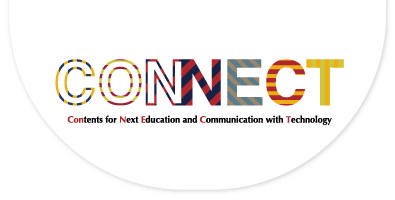TopicsTeacher Interview
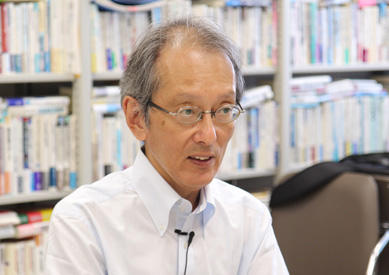
Twitter and PandA: Transforming the Quality of Communication and Relationships
Professor Jun Yoshida, Graduate School of Human and Environmental Studies, Kyoto University
The students tweet during class. Under normal circumstances, they would be accused of having a low level of interest in participating in the class. But what if tweeting were encouraged as one form of class participation? Not only that, what if they earned marks for class participation for each of the thoughts and questions that they tweeted and, in some cases, the professor mentioned their tweets and commented on them on the spot?
When we heard that there were such lectures in one of the sociology classes, we went directly to the course professor to ask about them. Our interview revealed that he was first attracted to online forums (those used before the Internet era and operated on membership and email services) and since then he has been researching the relationship between information and communication technology (ICT) and society. The interview also showed that he has spent long years trying to create a spirit of "conviviality" in his classes.
- PROFILE
- Ph.D. in Letters and Professor of the Course of Human and Socio-Cultural Studies at the Department of Human Coexistence, Graduate School of Human and Environmental Studies, Kyoto University, since April 2014
- Previously, Assistant Professor at Faculty of Letters, Kyoto University, Associate Professor in the Faculty of Integrated Human Studies, and Professor at the Center for the Promotion of Excellence in Higher Education
- Published Intānetto kūkan no shakaigaku: Jōhō nettowāku shakai to kōkyō ken (The Sociology of Cyberspace: The Public Sphere and Information Network Society), Sekaishisōsha, 2000
- Co-authored Modanitī no henyō to kōkyō ken (The Transfiguration of Modernity and the Public Sphere), punblished by Kyoto University Press in 2014
- Designed all by himself the server in his home department of Sociology in the Graduate School of Letters in 1996 and in charge of the website management committee for the Faculty of Integrated Human Studies in 2001
- Created his own website about twenty years ago, and continued to take an active role in disseminating information (Click here to visit his website)
Tweeting as Students Participate in the Sociology Course
First, may we ask you how you incorporate information and communication technology (ICT) in your classes?
I use Twitter during class to have the students tweet their thoughts and opinions in real time. At the same time, I have created a site on PandA* where I have them write review exercises as the "public assignments", and give feedback as the "reactions and comments". I have them create special accounts on Twitter and designate the hashtag so that students can share comments among themselves. The second page of the materials that I hand out contains screenshots of the most recent Twitter exchanges.
* PandA: A learning management system (LMS) provided in Kyoto University's Institute for Information Management and Communication. Click here for more details.
When I look at these materials, I can see that the students have actively tweeted.
That's right. At first, there were not many students who were interested in participating in tweeting, but there has been a relative increase since the year before last.
In the classes where you use Twitter, what themes do you deal with?
I use it in two courses: Sociology I and Socio-Information Studies. The former is a liberal arts and sciences course that covers a wide range of sociological themes, while the latter is a mixed undergraduate-graduate course in which I deal with rather specialized themes.
Does the nature of the tweets change depending on the content of the course, with some being centered on questions and others centered on thoughts?
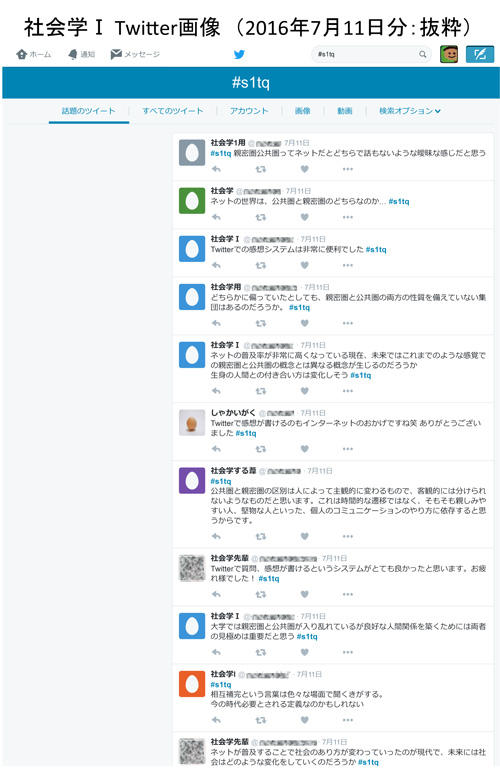
Some of the actual tweets that students have sent during class.
While tweets are supposed to be sent only during class, it is clear that students are taking an active approach to submitting comments and questions. (Image supplied by Professor Yoshida. Identifying details have been obscured.)
The overwhelming majority of tweets are about thoughts. Even when the students ask questions, they tend to ask simple or basic ones. For example, the last lecture in this academic year's course discussed globalization, and one student asked, "Are nations necessary?" This is a pretty basic question, but certainly when we talk about globalization, we can say in fairness that it is an essential question. In response to this kind of question, I take it up in class and comment, "Nations perform a variety of roles, but in connection with globalization, regulating the economy and redistributing wealth are the most basic functions of a nation, and the contradiction between those roles and globalization has led to today's phenomena of xenophobia and populism."
When do the students send these tweets about their questions and thoughts? During class or after class?
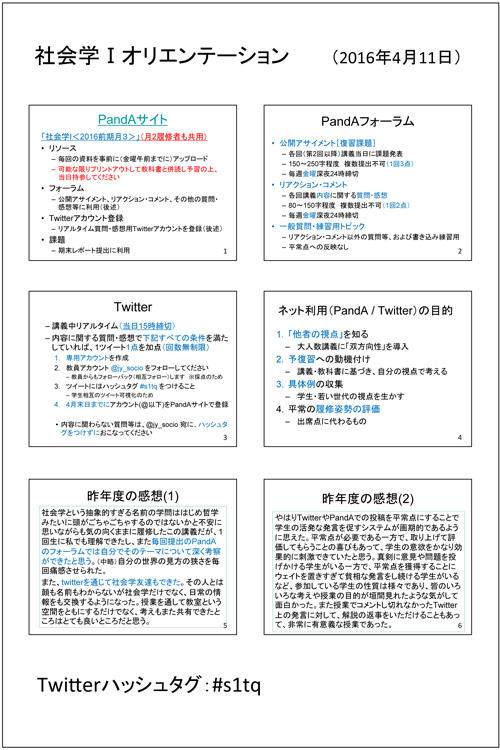
An excerpt from the material that are handed out to the students during orientation. We can see that Twitter and PandA are well integrated into the class. (Document provided by Professor Yoshida. The name of the document and other information have been added.)
As a rule, they do so during class partly because I want to comment on them on the spot. Still, I tell them that it is all right to tweet anything that they may have thought of after class, and I give them marks for class participation on the number of tweets. (On the left is an outline of the course.)
In such cases, how do you calculate the marks for class participation?
It's all very mechanical: one tweet equals one point. Note, however, that I set a time limit so that, as a rule, only tweets in real time during class count. On PandA, each public assignment counts as three points, and each reaction or comment counts as two points. Students may earn a maximum of 40 points, and if they participate wholeheartedly, they soon reach 40 points. Therefore, I tell them to participate on whatever time schedule they like. Even so, there are students who provide a steady stream of comments.
So the students don't necessarily participate just to earn points?
Well, among the thoughts expressed during the last academic year was the opinion that while some students were serious about expressing their opinions, there were some who just continued sending out poorly thought-out messages simply to earn points. Participation in and of itself seems to affect students' awareness. I feel that the way students' awareness is reflected in these thoughts is rather interesting.
Arriving at Parallel Use of Twitter and PandA as a Result of Trial and Error
It's interesting to see the students' awareness of the issues emerging. When did you start using Twitter in class?
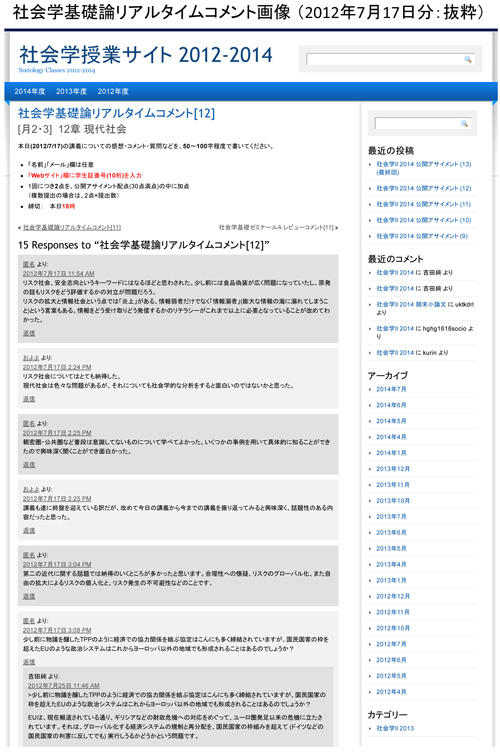
A screenshot of the Sociology Class Website 2012-2014, built with WordPress. It is clear that there were a lot of comments from students at that time. (Document provided by Professor Yoshida. The name of the document and other information have been added.)
I first introduced the use of Twitter in 2013, so it was about three years ago.
Before that, I worked through trial and error, and before Twitter, I used the content management system (CMS*) known as WordPress to build a dedicated website (see image at left).
That's the document titled "Sociology Class Website 2012-2014," which I just handed to you. With every lecture, I created an entry and had students give their reactions, but it was a dedicated website and the students were not required to use it. Therefore, the only students who participated were the ones who wanted to do so. Still, I thought that having a system with a somewhat lower threshold would encourage more students to actively participate, so I decided to start using Twitter.
*CMS is a general term for a system that takes the text, images, and layout information that make up web content and manages them in an integrated and systematic manner. Published as open source software, WordPress is one of the most powerful of the many CMSs.
When did you start using PandA, which you are currently using in conjunction with Twitter in your classes?
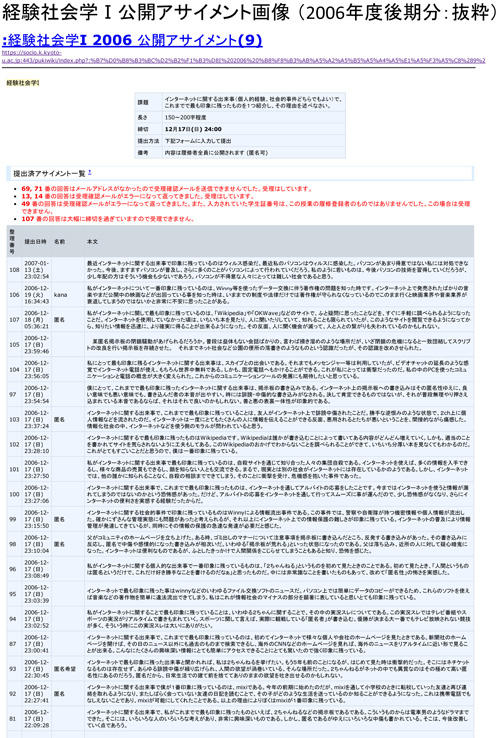
A screenshot of the private website used in Empirical Sociology I, taught in the second semester of 2006.
We can see from this that the type of ICT used changes with the times. (Document provided by Professor Yoshida. The name of the document and other information have been added.)
Two years ago in 2014.
Unlike Twitter, PandA is not for responding in real time. Instead, I use it for homework assignments-for having the students write brief reports before the next week. I first tried something similar ten years ago. Since PandA didn't exist at the time, I created an independent website on my own server and had the students hand in the public assignments that I mentioned previously. The oldest document I have left is a public assignment from 2006, one I used in a liberal arts and sciences course called Empirical Sociology I (see image at left). I used PukiWiki to create the website. Until then, I used a 2channel (ni channel)-formula bulletin board for the same type of thing, but I removed it and there's nothing left of it.
You used media that were commonly used at the time, and gradually shifted to the current format. A conventional reflection sheet is a method for gathering the students' thoughts and opinions, but does it have a different role from these media?
The concepts are the same, but the major difference is that the students can read what the other students are writing. I think that it is important to "publish" the content of the questions and thoughts, but when I read students' thoughts at the end of the term, I find that most of them feel that knowing what other students think is very stimulating, so I think this format is fulfilling my initial objectives.
Another difference is that, from the instructor's point of view, having digital data remaining makes it simple to figure out marks for class participation. If they're recorded on a paper sheet, then you need to calculate them by hand.
How to Elicit Two-Way Communication Without Watering Down the Course Content
Till now We have been asking about the technical aspects of the changes. Now I'd like to ask about the educational aspects. Do you feel that the quality of learning has changed with the introduction of ICT into your class?
That depends on how you define "learning." Viewed in terms of "output," my impression is that there hasn't been much of a change. But if you think of learning in terms of everything it involves, not just in terms of output but in terms of students' attitudes toward class participation in real time, I have a definite sense that classes are more lively.
Particularly with Twitter, when students can ask the instructor questions and receive an answer in real time, the attitude of the class may change, too.
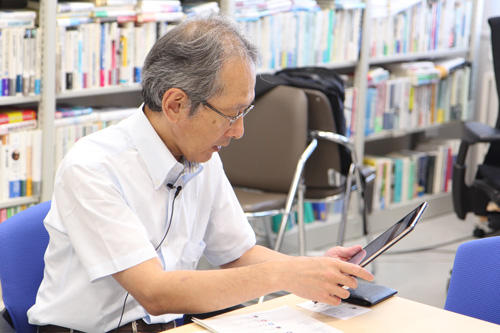
During the interview, Professor Yoshida checks the content of comments that came up in class. He also carries this iPad into the classroom and responds to students' questions and comments.
That's right. The sense of participation arises on its own. I can say that it's not only true of Twitter but also of the public assignments that I have the students write after class. Ever since I started the public assignments, I have selected a few of the interesting reactions and presented them with comments during the next lecture. The students whose reactions are presented have left remarks such as "I was nervous about it, but it was a great encouragement to me." In some cases, I can elicit that kind of sense of participation, even if it's not in real time.
From the students' point of view, having their carefully written thoughts discussed in class and being able to receive feedback leads to an attitude of wanting to participate, right? You design your classes with awareness that the students will participate with you.
Yes, I do. I have heard that there are many instructors who try to encourage participation through such means as incorporating group discussions. That is effective to a certain extent, but when you do that, the discussions inevitably end up taking a lot of time, which leaves less time to devote to the lecture, so it feels like a sort of bottleneck.
For a long time, I have considered the question of how to make nearly two-way communication possible without cutting down the amount of time devoted to lectures and also encouraging the students' sense of participation, but I think that my current format is one of the solutions.
Current Research and Educational Practices That Began with the Sense That Participation is Interesting in Itself
I think that encouraging students' active participation without watering down the course content during the lecture is an extremely interesting point.
Just before this, the key phrases "making communication visible" and "two-way" came up. Do the experiments that you are implementing in your classes now have any connection with your research?
Actually, the motivation for my current research started from one of my hobbies.
Beginning around the 1990s, before Internet participation was really widespread, I was involved in online forums,* and not as an individual user. Instead, I established a network that I administered myself, creating a venue for communication. This was a very stimulating experience, and it also led to my research, so that now the object of my research is issues concerning communication or community in an Internet-oriented society. What is stimulating about this is my sense that ICT and computer networks and things like that are not mere tools, but are communities in themselves, and that the very act of participating in them is interesting. That feeling was the most essential experience in beginning my research.
On that point, about the time the Internet was emerging in the U.S., there were developers who were called "hackers," and in the same way, they did not employ the ICT merely as tools. They tended to find it interesting in itself to use technology to create venues. There is a theoretical basis for this too, presented in Ivan Illich's book Tools for Conviviality. The word "conviviality" can sometimes be translated by Japanese words that mean "independent co-existence," but that definition seems a bit too stiff. In more understandable terms, it has the nuance of gathering in a friends group, finding something interesting, pursuing that interest together, and enjoying the very act of doing so. Illich uses the word as a concept in theories of technology, but it may be a concept that is also applicable to pedagogy, too.
*Online forums: A form of online service used before the Internet became widespread, involving members-only forums and email services.
In that sense, how do you perceive the community within the class?
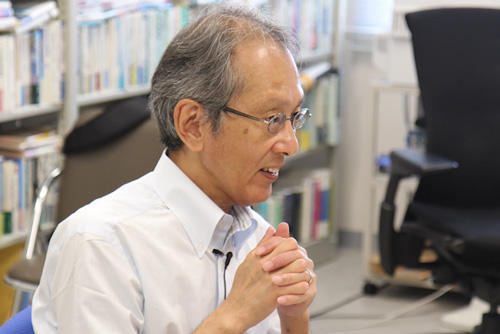
Professor Yoshida mentions that his first experience that led to his current research and classroom teaching was involvement with administering a network community during the era of online forums.
"I was attracted to ICT not as a tool but as a community."
This history is also described on Professor Yoshida's website.
In class, the instructor and the students are in a sort of power relationship, and I think we need to ensure that the students are constrained by this power relationship as little as possible. With a somewhat anonymous system like Twitter, the students are at least somewhat anonymous from one another, although not completely, so a major advantage of Twitter is that students can "speak" without attracting the attention of other students. I think this is one effective method or means of making sure that the students are not constrained by power relationships.
So the quality of communication and connectedness between the instructor and the students changes. Does it mean that student reactions that would be hard to ask as questions can be more easily expressed through media such as Twitter?
That's right. It becomes very easy for them to express themselves. If the number of students in a lecture is not very large, you can target the students who are sitting in front and have them speak, but in large lecture classes, like the ones in the liberal arts and sciences curriculum, that gradually becomes more difficult.
Even in a class like Socio-Information Studies, a combined undergraduate-graduate course, which is open to several undergraduate faculties and graduate schools, including the Faculty of Integrated Human Studies, the Graduate School of Human and Environmental Studies, the Faculty of Letters, the Graduate School of Letters, and the Graduate School of Energy Science, students from a wide variety of backgrounds from both the sciences and the humanities-participate in it. For that reason, most of the students are unfamiliar with one another, so it's a rather anonymous place. Partly for that reason, using something like Twitter, which allows the students to speak anonymously, makes it easier for the students to speak.
I see.
The first materials I received gave "collecting specific examples (making use of the viewpoints of students and the younger generation)" as the objective of using the Internet (PandA and Twitter). At this point, has there been anything that has impressed you?
I can think of quite a few, but when I lectured on gender, students tweeted examples of "paternity harassment." That refers to the problem of men being harassed by superiors and colleagues for taking paternity or childcare leave. Of course, I already knew the phenomenon itself occurs, but I didn't know the actual word, so finding out what it was called was a discovery for me. As I continue looking at the students' reactions, I get the impression that their interests have changed a lot in the past ten years. I think another example is that attitudes toward sexual minorities have also changed a lot.
Being able to mention specific examples of things I hadn't thought of in class gives the students a feeling of immediacy about the field of sociology.
When we think of the fact that the diversity of media and the diversity of values have had co-occurrence relations, it is fair to say that your classes themselves become a venue where students can experiment with sociological problems in real time.
Indeed.
Not Only Students but Also Instructors Need to Be Treated in Ways That Lower the Hurdles
In the future, the trend of using ICT in Kyoto University classes will accelerate, but when that happens, what kinds of possibilities do you think will open up?
There are all kinds of possibilities, so I can't speak in general terms. But on the technological side of things, we need ways to lower the hurdles to technology, not only for students but also for instructors who use it. For example, in my case, I reflect the use of Twitter in marks for class participation. Because collecting the tweets of large numbers of students and calculating their points by hand is a laborious task, I use a programming language called PERL to calculate them. Mechanisms for supporting things like that will be increasingly necessary. It would also be helpful to make systems customizable and flexible to a certain extent.
When instructors are thinking of starting to use ICT in their classes or when instructors unfamiliar with using ICT introduce it, that's very gratifying. Are there any other things to keep in mind?
When you aren't accustomed to a system, you shouldn't dive right into it. Instead, you should set up a trial period for about a semester. When you try things out, you may run into problems you didn't expect. With Twitter, for example, unless students have a registered account, you can't give them credit for marks for class participation, but sometimes the students make mistakes in writing when they register, or they insert invisible spaces, which makes it impossible for the program to search their accounts and yield the proper number of points. In order to overcome those technological problems as easily as possible, you need to introduce the technology on a trial basis once.
On the other hand, if you use Twitter not for adding up marks for class participation but just for getting an idea of the students' thoughts, that lowers the hurdle. In that case, the trick is to attach a hashtag. That makes it easy for the instructor and the students to share tweets.
How do you handle account administration?
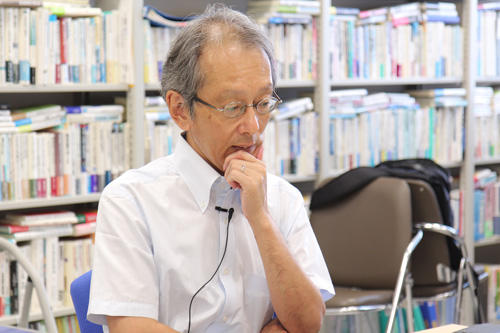
According to Professor Yoshida, "You need know-how when you actually use ICT in class." He emphasized that university-wide support is needed for instructors who will start to use ICT in their classes, and then he mentioned some specific techniques.
I've done that on a trial-and-error basis. I used to set up a dedicated website and have the students register there, but there were a lot of mistakes with account numbers and student identification numbers. So this academic year, I used PandA's test function to have them register only their Twitter accounts. The students' identification numbers are already registered with PandA, so no errors occur there. I have been trying various methods to leave Twitter logs, but at present I require everyone to follow me by the third class after the beginning of the semester, and I follow them. When I do that, a record of tweets is left on my timeline.
Even if you decide to use technology in class, you need to become accustomed to it.
That's right. You certainly have to know all sorts of little tricks in order to use it in class. With Twitter, for example, knowing when to comment is an important point. Commenting at odd times disrupts the flow of the class, so you have to make judgments on a case-by-case basis. I bring in an iPad, separate from the computer that I use for projecting slides. I use it to check the Twitter timeline as needed, and I try to comment when the lecture reaches a natural stopping point. Sometimes I take tweets that I couldn't follow up on during class, look at them after class, and reply to them.
The use of ICT is generally encouraged, but when I hear what you have to say, there seems to be a large element of relying on the individual instructor's technical literacy for administration and the like.
Right. I hope the university will build systems that support this aspect of it. For example, when it comes to linking KULASIS and PandA, well, KULASIS lists names by faculty, school, and institute while PandA lists names by class. For example, in a class like Socio-Information Studies, which is open to several faculties and schools, it would be convenient to have a system that could assign grade points on a roster linking the two systems. I'd really like to ask the university to do this. Also, when you use PandA's forums tool, it is set up so that you can always see who has spoken. Depending on the instructor or the content of the class, it may be better to allow anonymity, so I think it would be even better to be able to customize the PandA forums in that way.
Thank you for your opinions based on actually using ICT. What you said was really informative. Thank you for taking time out from your busy schedule.
It was my pleasure. Thank you.
For Professor Yoshida, who has been involved with building his own websites since the early days of the Internet and PC technology, the most important thing in using current ICT in teaching was creating a community that is fun to participate in, and this belief came from his own teaching experience that made a profound impression on him.
On that point, the most interesting thing he said was that two students had become "sociological friends" with each other through their Twitter exchanges during class. According to Professor Yoshida, the two have never seen each other's faces or don't know each other's names but exchange opinions and information on Twitter. However, this leads to motivation for them to study sociology. From the students' point of view, a community that is fun to participate in has arisen. This conversation was an opportunity to sense the possibilities of teaching with the use of ICT.
Questions asked by Motoko Okumoto and Takeo Suzuki
Article composition: Takeo Suzuki
Interview date: July 29, 2016
Published online: May 15, 2017 (Original article)
May 21, 2018 (English article)
